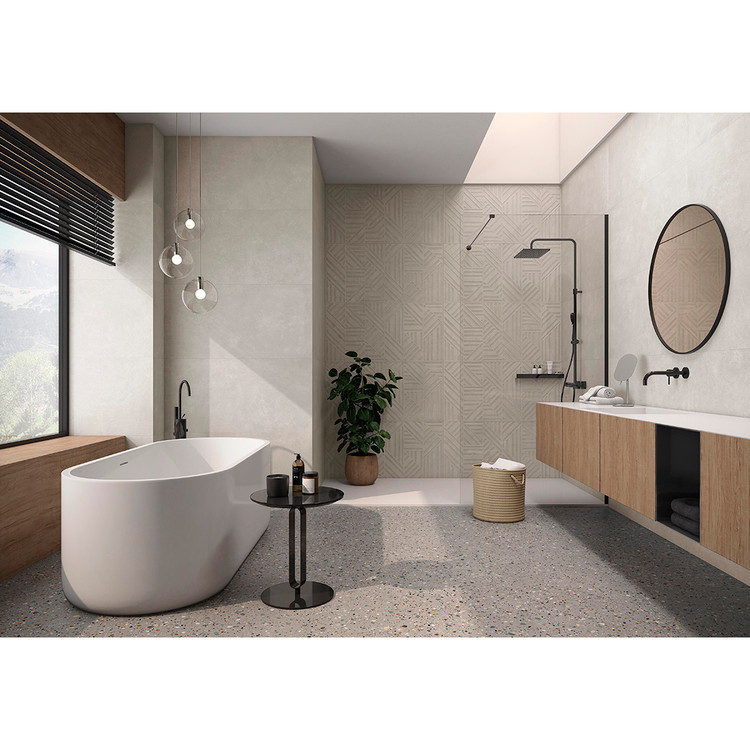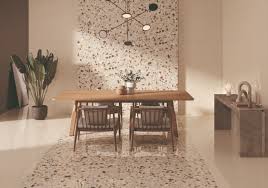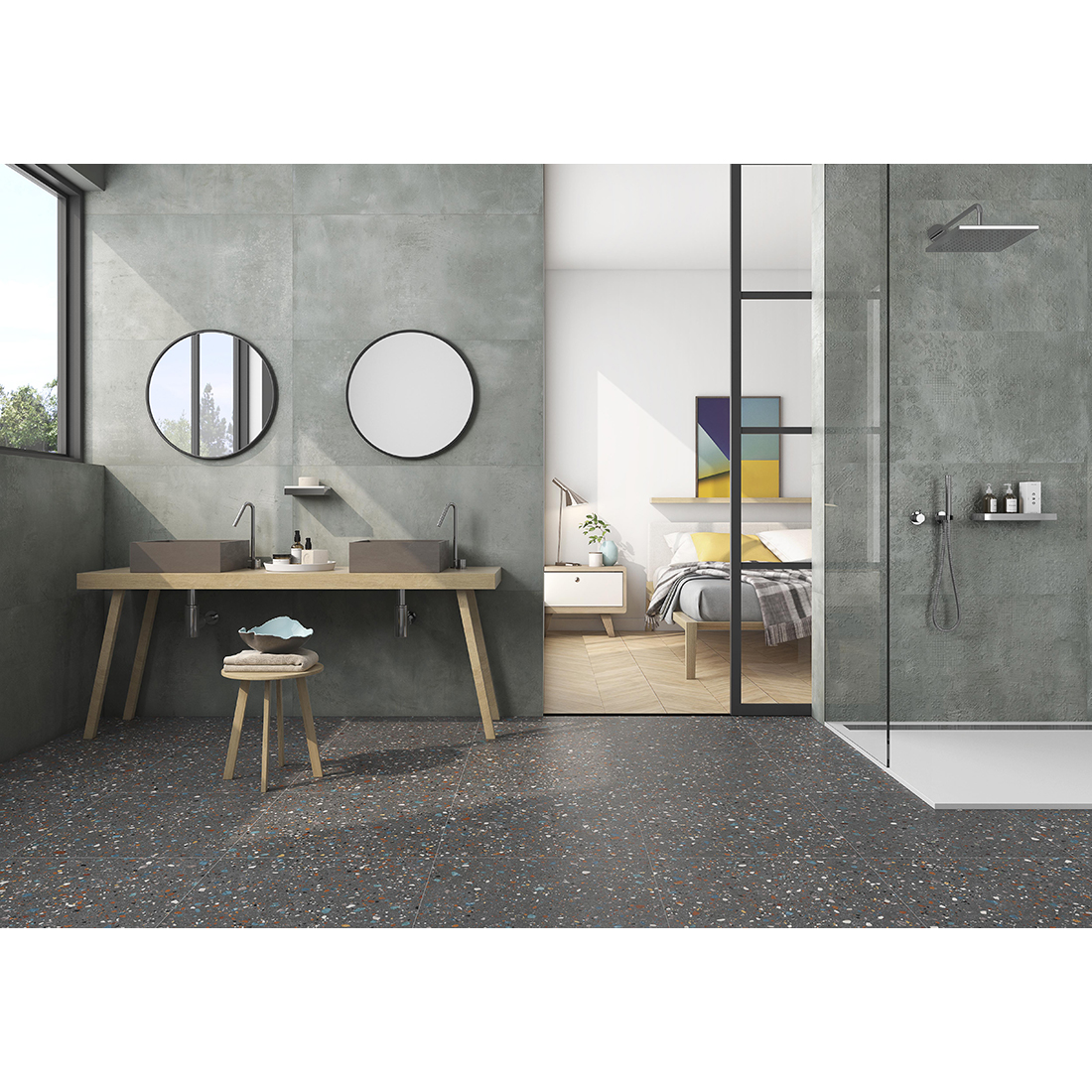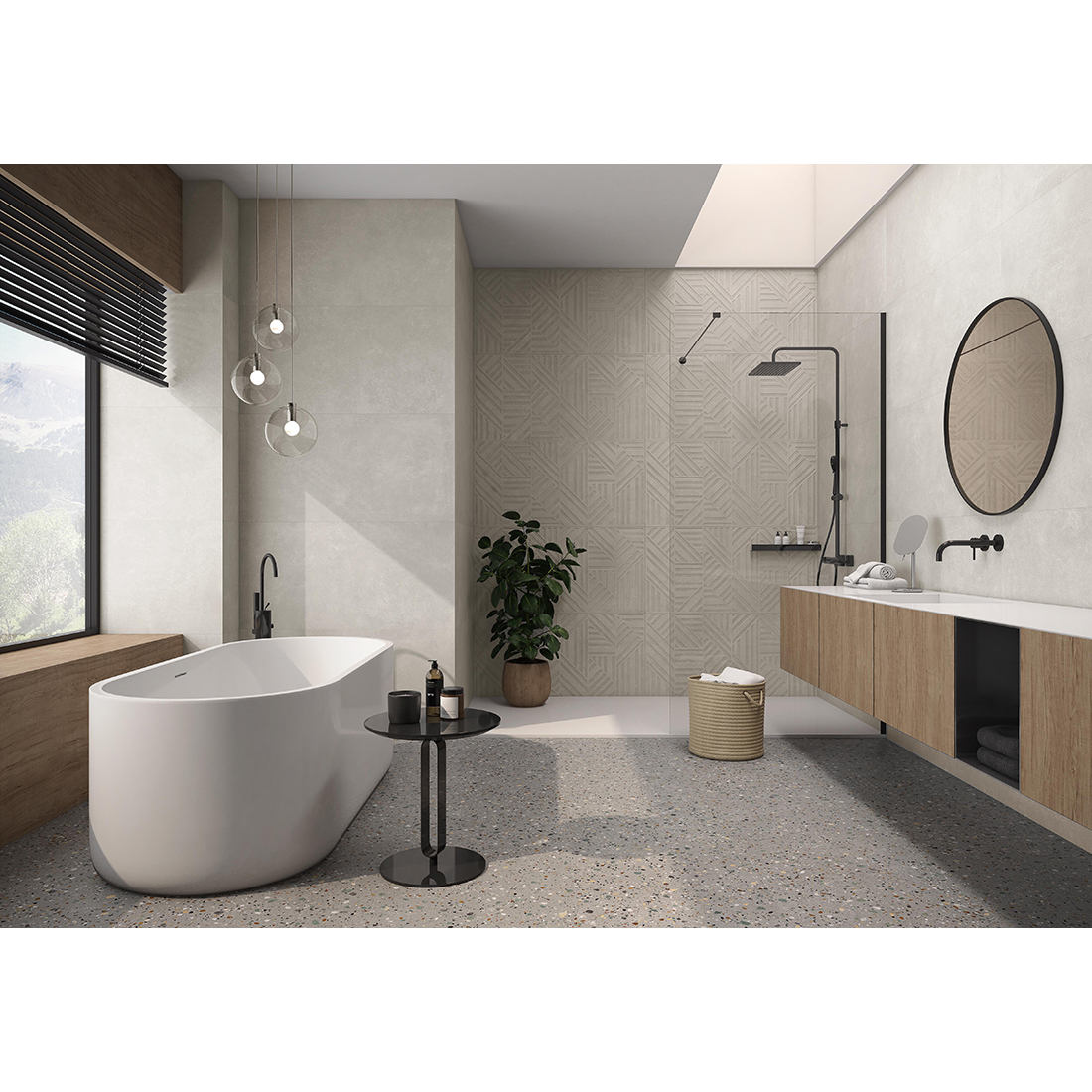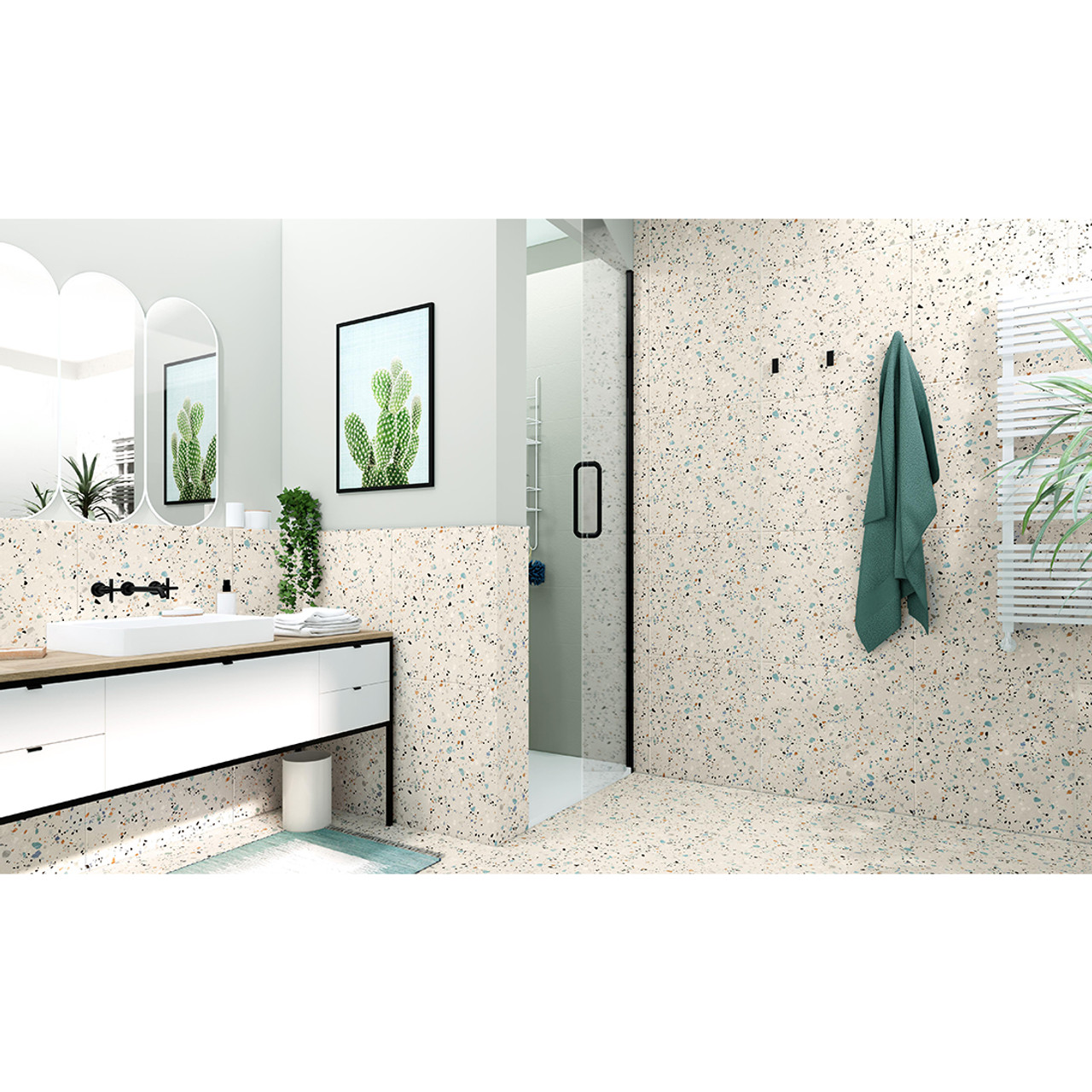A Comprehensive Guide to Terrazzo Tiles
Posted by As'ad Mansoor on 14th May 2024
Origin of terrazzo style tiles
Terrazzo, meaning 'terrace' in Italian, traces its origins back to ancient Egypt, but it was the Venetians who elevated the material to an art form in the 15th century. Initially, terrazzo was created as a low-cost flooring material made from chips of discarded marble set into clay and sealed with goat's milk. This method provided a robust and decorative surface for Venetian workers' homes, crafted from remnants of upscale building projects.
Evolution and Spread
During the Renaissance, this technique was refined and terrazzo became popular among the affluent as a high-quality material for flooring in palazzos. The introduction of a new binding agent, cement, in the 18th century, enhanced its durability and aesthetic appeal, allowing for finer polishing and a smoother finish.
As Italians migrated, they brought the craft of terrazzo with them, spreading it to various parts of the world. By the 1920s, terrazzo installation had become widespread in the United States, particularly in Florida and other parts of the South where Italian immigrant communities thrived.
Cultural Influence
The versatility and durability of terrazzo made it an attractive choice in the burgeoning architectural styles of the early 20th century, particularly with the rise of Art Deco and Modernism. The material's ability to be cast in situ made it popular for creating expansive, seamless surfaces that were integral to the aesthetic of these movements. Its use in iconic buildings and in public transportation systems, like the Hollywood Walk of Fame, cemented its status not just as a functional material but as a cultural symbol of longevity and creativity.
Modern Revival
In recent decades, terrazzo has seen a resurgence due to its sustainable qualities and aesthetic flexibility. Modern terrazzo mixes traditional and contemporary materials like recycled glass and metal aggregates, enhancing its visual impact and environmental appeal. Its adaptability has allowed designers to use it in more innovative and colourful ways than ever before, ensuring that terrazzo remains a staple in both residential and commercial architecture.
The legacy of terrazzo is a testament to its functionality and artistic potential. It continues to influence design and architecture worldwide, bridging ancient techniques with contemporary innovations.
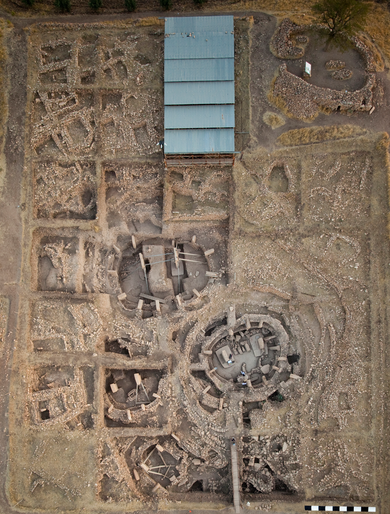
An archaeological site in the Urfa Province inside Turkey dating back 9000BCE. Some of the floors on this site are made from Terrazzo.
The Evolution of Terrazzo: From Traditional to Porcelain Floor and Wall Tiles
Traditional Terrazzo
Traditionally, terrazzo is made by embedding pieces of marble, quartz, granite, or glass into a cementitious binder. After it hardens, the surface is ground and polished to reveal a beautifully speckled texture. This method, rooted in Venetian architecture, has been valued for its durability and aesthetic appeal, particularly in large, seamless floor installations.
Shift to Porcelain Terrazzo Tiles
The shift from traditional terrazzo to porcelain terrazzo tiles represents a significant technological and aesthetic evolution. This transition was driven primarily by advances in manufacturing technologies and a growing demand for materials that offer easier installation and maintenance without compromising the iconic terrazzo look.
Advantages of Porcelain Terrazzo
- Ease of Installation: Unlike traditional terrazzo, which is poured in place and takes time to cure, porcelain terrazzo tiles are pre-manufactured and ready to lay, significantly reducing installation time and complexity.
- Cost-Effectiveness: Porcelain tiles are generally less expensive than traditional terrazzo because they are easier and less costly to produce in bulk.
- Consistency and Quality Control: The manufacturing process for porcelain tiles allows for greater control over the colour and size of the chips, leading to a more uniform product that still mimics the random aesthetics of traditional terrazzo.
- Durability and Maintenance: Porcelain tiles are incredibly durable and resistant to staining, making them suitable for both high-traffic commercial environments and residential spaces. They are also easier to maintain than cement-based terrazzo, requiring only regular cleaning without the need for periodic resealing.
- Technological Enhancements: The development of digital printing technologies has also played a crucial role in the evolution of porcelain terrazzo. High-resolution digital printers can imprint detailed and varied terrazzo patterns onto porcelain tiles, closely mimicking the look of real stone chips. This technique has expanded the design possibilities far beyond the natural colour limitations of traditional terrazzo materials.
- Sustainability Considerations: Furthermore, porcelain terrazzo supports environmental sustainability through the incorporation of recycled materials. The production process often includes recycled porcelain, further reducing the ecological footprint of new construction and renovation projects.
The adaptation of porcelain to replicate the terrazzo effect is a reflection of the industry's response to market needs for more accessible and maintenance-friendly flooring options that do not sacrifice style. As manufacturing techniques continue to advance, the line between traditional craftsmanship and modern production methods blurs, offering architects and designers innovative ways to keep historical aesthetics alive in contemporary spaces.
The Rise of Terrazzo-Influenced Porcelain Tiles in the UK Market
The UK market has witnessed a significant rise in the popularity of terrazzo-influenced porcelain tiles, reflecting broader trends in both residential and commercial design. This increase in popularity can be attributed to several factors, including technological advancements, aesthetic versatility, and a growing emphasis on sustainability.
- Technological Advancements: Advances in digital printing and manufacturing technologies have made it possible to create porcelain tiles that closely mimic the look of traditional terrazzo. These technologies allow for high-resolution, detailed patterns that replicate the unique, speckled appearance of terrazzo with impressive accuracy. This has made porcelain tiles a popular choice for those seeking the terrazzo aesthetic with the benefits of modern tile technology.
- Aesthetic Versatility: Terrazzo-influenced porcelain tiles offer an array of design options, making them suitable for a variety of settings. Available in numerous colours, patterns, and finishes, these tiles can be used to create bespoke interiors that range from contemporary minimalism to eclectic traditionalism. Their ability to blend with different décor styles has made them a favourite among interior designers and architects across the UK.
- Sustainability and Practicality: Porcelain tiles are known for their durability and ease of maintenance, attributes that make them particularly appealing in the context of sustainability. Many porcelain tiles include recycled materials, which appeals to environmentally conscious consumers and businesses aiming to reduce their ecological footprint. Furthermore, the durability of porcelain reduces the need for frequent replacements, contributing to a more sustainable construction model.
- Economic Factors: The cost-effectiveness of terrazzo-influenced porcelain tiles compared to traditional terrazzo has also contributed to their rising popularity. These tiles offer a more affordable way to achieve a high-end look, making them accessible to a broader range of consumers and projects.
- Market Trends: The UK's market trends reflect a wider global movement towards materials that offer both style and substance. Terrazzo-influenced porcelain tiles have been incorporated into numerous high-profile projects, from luxury residential developments to commercial spaces like hotels and restaurants, showcasing their growing appeal.
In summary, the popularity of terrazzo-influenced porcelain tiles in the UK is driven by their technological sophistication, versatile aesthetics, sustainability credentials, and economic advantages. This has positioned them as a preferred choice for both new builds and renovations, signalling a robust future for this style in the UK's tile market.
Colours of Porcelain Terrazzo Tiles
Porcelain terrazzo tiles are celebrated for their vibrant range of colours and patterns, which can dramatically enhance the aesthetic of any space. Traditionally, terrazzo was made with chips of marble, quartz, granite, or glass set into a cement base. Today, porcelain versions replicate this look with almost limitless colour options. Modern manufacturing processes allow for a vast spectrum of hues, from neutral tones like grey, white, and black, to bolder and more vibrant colours such as blue, red, and green. These colourful tiles often feature contrasting chips that can add a pop of visual interest to the floor or walls where they are installed.
Appeal of Porcelain Terrazzo Tiles
The appeal of porcelain terrazzo tiles lies in their combination of timeless beauty and contemporary functionality. They offer the classic charm of traditional terrazzo while providing the benefits of modern porcelain, such as durability, ease of maintenance, and moisture resistance. These tiles are perfect for those seeking a unique flooring option that stands out due to its artful appearance and longevity. Their speckled look not only hides dirt and scuffs but also contributes to a lively, dynamic environment, making them a favoured choice in design-forward projects.
Different Settings for Porcelain Terrazzo Tiles
Porcelain terrazzo tiles are versatile enough to be used in various settings, enhancing both indoor and outdoor spaces. In residential settings, these tiles are often used in kitchens, bathrooms, and entryways where their durability and moisture resistance are particularly beneficial. In commercial spaces, such as hotels, restaurants, and office buildings, terrazzo porcelain tiles contribute to an upscale, visually appealing environment that can withstand high traffic. The ability of these tiles to merge functionality with aesthetic appeal also makes them a popular choice for educational and healthcare facilities, where both durability and a pleasant ambiance are crucial.
Overall, porcelain terrazzo tiles adapt beautifully to a variety of design needs, making them a smart and stylish choice for a wide range of decorating projects. Whether installed in a contemporary loft or a more traditional home, these tiles bring character and style to any décor.

In the image provided, the use of terrazzo-style porcelain tiles beautifully anchors the modern, minimalist design of the room. The spacious area is characterized by large, gleaming windows that frame a stunning view, suggesting an urban setting, possibly in a high-rise apartment. These expansive windows not only flood the space with natural light but also accentuate the reflective sheen of the porcelain terrazzo floor, enhancing its colourful specks and intricate patterns.
The terrazzo tiles themselves are a key design element. They provide a dynamic yet unobtrusive foundation for the room's décor, their varied colours and textures adding depth and interest without overwhelming the space. This is a perfect example of how terrazzo-style porcelain can complement a contemporary aesthetic - its practicality and visual appeal are well-suited to modern living spaces that value clean lines and open layouts.
Furniture within the room is sleek and modern, with a low-profile dark sofa contrasting sharply against the bright floor. A minimalist coffee table in the centre, featuring a thin metal frame and a glass top, adds to the airy feel of the room. The overall palette is neutral, with the floor's vibrant details providing subtle bursts of colour.
This setting exemplifies how terrazzo-style porcelain tiles can be effectively used to enhance modern interior design. Not only do these tiles meet the practical demands of high-traffic areas, but they also contribute to the aesthetic harmony of spaces designed to feel open and light-filled. The choice of terrazzo porcelain here underlines a preference for durable materials that do not sacrifice style for functionality, blending beautifully with the room's modern décor and expansive architectural elements.
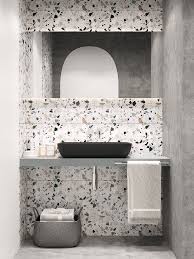
In the image, terrazzo-style porcelain tiles are ingeniously used to create a feature wall, enhancing the visual interest and texture of a compact bathroom space. This design choice not only draws the eye but also adds a sense of depth and character to the area.
- Feature Wall: The terrazzo tiles on the wall surround the mirror and the vanity, creating a continuous visual flow that is both striking and cohesive. The large pieces of aggregate in the tiles are varied in colour—black, white, grey, and hints of warm brown—which provides a lively contrast to the otherwise muted colour scheme of the room.
- Complementary Elements: The smooth, matte black basin on the vanity complements the black specks in the terrazzo, while the sleek faucet and minimalistic bathroom accessories maintain the modern aesthetic. The use of a simple, unadorned mirror with an arched top softens the otherwise angular features of the tiles and fixtures.
- Colour Scheme and Lighting: The room's palette is predominantly monochromatic, relying on the texture and pattern of the tiles to inject style and dynamism. Natural light, possibly from a hidden source or diffused through frosted glass, subtly enhances the texture of the terrazzo, highlighting its unique elements without overpowering the space.
Functional and Aesthetic Appeal:
The terrazzo porcelain tiles are an excellent choice for wet areas like bathrooms due to their water resistance and ease of maintenance. The aesthetic appeal of the terrazzo, particularly in a feature wall setting, lies in its ability to add complexity and visual interest to a space without additional décor elements, making it ideal for minimalistic or smaller spaces where clutter needs to be minimized.
This use of terrazzo-style porcelain tiles exemplifies how modern materials can mimic classic designs while delivering functionality and enhancing the aesthetic value of interior spaces. The design successfully marries practicality with luxury, creating a bathroom that feels both contemporary and timeless.
In the image, terrazzo-style porcelain tiles are expertly utilized both as flooring and as a feature wall, illustrating a seamless integration of vertical and horizontal elements that enhances the overall design coherence of the room. The terrazzo tiles, speckled with greys, blacks, and warm brown tones, provide a dynamic yet unifying backdrop that complements the earthy and neutral colour palette of the setting.
The space is styled with a minimalist and somewhat rustic aesthetic, emphasizing clean lines and natural materials. A robust wooden dining table, paired with mid-century modern chairs, centres the room, serving as a focal point. This combination of wooden furniture against the terrazzo backdrop creates a warm, inviting environment that balances modernity with natural elements.
The room benefits from soft, ambient lighting provided by a contemporary ceiling fixture, which casts a gentle glow that highlights the textured surface of the terrazzo tiles. The use of natural materials is further echoed in the décor with a potted plant and simple kitchen accessories, enhancing the room's organic feel.
The choice to extend the terrazzo from the floor up the wall transforms the space, making the room appear larger and more open while adding visual interest and depth. This design choice not only maximizes the impact of the terrazzo's aesthetic appeal but also illustrates the versatility of porcelain tiles in creating cohesive indoor spaces that are both beautiful and practical.
This application of terrazzo-style porcelain tiles demonstrates their ability to elevate a space through texture and pattern, proving that these tiles can effectively transform a simple room into a sophisticated and harmoniously designed area.
In the image provided, terrazzo-style porcelain tiles are masterfully utilized both on the floor and as a distinct feature within a sophisticated bathroom setting, showcasing the versatility and visual appeal of terrazzo in contemporary interior design.
Design and Aesthetics
The room features a striking terrazzo floor in rich, dark hues peppered with brightly coloured chips that add a vibrant contrast to the otherwise muted colour scheme. This lively flooring extends the dynamic character of the space, providing both a practical and decorative foundation. The use of similar terrazzo-style tiles on the bathroom walls creates a cohesive look, seamlessly blending the floor with the vertical surfaces, which are otherwise dominated by large, minimalist concrete tiles in a uniform grey tone.
Functional Space and Layout
The bathroom is divided into distinct zones, with a clear glass partition separating the wet area of the shower from the dry area, where a double vanity unit is installed. This layout not only enhances the functionality of the space but also allows the terrazzo tiles to be a focal point across the different zones, unifying the area under a singular design theme.
Furnishings and Fixtures
The minimalist approach continues with the furnishings. A simple, robust wooden table serves as the vanity, supported by industrial-style metal legs that complement the modern aesthetic of the room. Above the vanity, twin round mirrors and minimalist lighting fixtures contribute to a clean, contemporary look that is both stylish and practical. The overall design is a testament to the idea that modern interiors can be warm and inviting through the use of textured surfaces and thoughtful composition.
Overall Impact
The combination of terrazzo tiles with the industrial elements and minimalist fixtures illustrates a trend in modern bathroom design that emphasizes both functionality and style. Terrazzo provides a durable and visually appealing surface that is ideal for wet environments, making it a practical choice for flooring and wall treatments in high-moisture areas like bathrooms.
This setting exemplifies how terrazzo-style porcelain tiles can transform a functional space into a striking design statement, marrying durability with contemporary aesthetics for a modern home.
The interior design of the bathroom in the image you've provided brilliantly combines textures and materials to create a serene and stylish space. The use of terrazzo-style porcelain tiles on the floor is a highlight, offering both durability and a splash of colour through its speckled pattern, which includes hints of darker tones and vibrant blues.
Wall Tiles and Textures
The walls are adorned with matte tiles that provide a subtle contrast to the glossy finish of the terrazzo floor. The main wall tiles are in a light grey hue, contributing to a tranquil and clean aesthetic. These are complemented by a feature wall with a geometric pattern that adds depth and interest without overpowering the room. The feature wall’s pattern is understated yet sophisticated, employing a design that echoes the complexity of the terrazzo but in a more subdued manner. This geometric pattern works harmoniously with the terrazzo floor, as both elements share a sense of permanence and classic design rendered in a contemporary style.
Wood Elements and Furnishings
The bathroom also incorporates wooden furnishings that warm up the space, providing a natural counterbalance to the cooler tones of the tiles. The wood used in the vanity and the shelves is of a light colour, which helps maintain the airy feel of the room. This wood is beautifully finished, showing off a natural grain that complements the organic elements of the terrazzo floor. The choice of wood and its placement alongside the wall and floor tiles demonstrate a thoughtful approach to material synergy, enhancing the overall aesthetic and tactile experience of the bathroom.
Overall Design Cohesion
The combination of these elements—terrazzo porcelain floor tiles, matte and patterned wall tiles, and wooden furnishings—creates a cohesive look that is both modern and inviting. The design choices in this bathroom exhibit a keen attention to detail and a balance between functionality and style. The terrazzo tiles, particularly, serve as the foundational visual anchor for the room, around which all other design elements are thoughtfully arranged to complement the floor’s playful yet elegant appearance.
This approach to interior design, where every component works in concert, showcases a sophisticated understanding of how textures, colours, and materials can coexist to create a space that is not only beautiful but also practical for everyday use.
This bathroom effectively showcases how terrazzo-style porcelain tiles can be used to create a cohesive and visually appealing design. The terrazzo tiles, adorned with a creamy base and flecked with specks of black, blue, and pink, cover both the floor and a feature wall, enveloping the room in a playful yet sophisticated pattern that enhances its overall brightness and spaciousness.
The continuity of terrazzo from the floor up the wall creates a striking visual impact, making the space appear larger and more integrated. This use of the same material on multiple surfaces simplifies the design while introducing texture and colour variation that adds depth without overwhelming the senses. The rest of the walls are kept in a soft, neutral tone, which balances the busyness of the terrazzo and complements its colour palette.
The bathroom features modern and sleek furnishings that resonate with the contemporary feel of the terrazzo tiles. The vanity unit, which is minimalist in design with clean lines and a white finish, contrasts subtly with the terrazzo, drawing attention without clashing. Its simple style prevents it from competing with the complexity of the floor and wall tiles, ensuring the terrazzo remains the focal point of the room.
The choice of chrome fixtures and fittings adds a touch of sophistication and mirrors the flecks within the terrazzo, enhancing the cohesion of the room’s design. The addition of green plants introduces a natural element that complements the earthy tones of the terrazzo, while the framed pictures on the wall echo its colours and contribute to the room's modern aesthetic.
Together, these elements combine to deliver a unique interior design that is both functional and stylish. The use of terrazzo-style porcelain tiles as both floor and wall coverings is a testament to their versatility and the dynamic effect they can achieve in interior design. This approach ensures the room remains light and airy, with the terrazzo providing texture and colour that enrich the space without overpowering it. The furnishings and décor are thoughtfully chosen to align with the terrazzo’s modern vibe, ensuring a harmonious and inviting bathroom environment.

